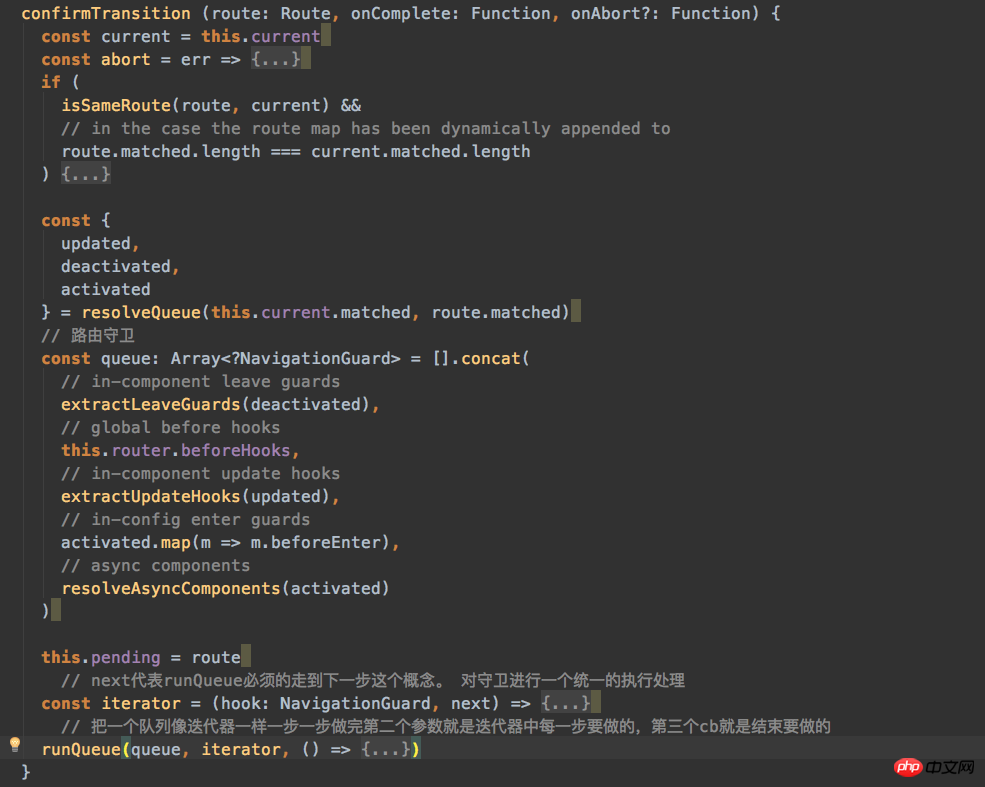本篇文章给大家带来的内容是关于带你彻底搞定vue-Router的导航守卫,有一定的参考价值,有需要的朋友可以参考一下,希望对你有所帮助。
在本期文章中,我将为大家梳理弄明白以下几个事情,
在之前说过的一个内容router实例的history属性帮助我们做了所有跳转部分的事情,所以导航守卫的内容也在history中。

我们以HTML5History这个类来看一下这个push方法,
push (location: RawLocation, onComplete?: Function, onAbort?: Function) {
const { current: fromRoute } = this
this.transitionTo(location, route => {
pushState(cleanPath(this.base + route.fullPath))
handleScroll(this.router, route, fromRoute, false)
onComplete && onComplete(route)
}, onAbort)
}push(我们跳转时的$router.push就是这个方法)过程中调用了transitionTo完成了一系列的跳转内容,但这个方法在HTML5的类中并不存在,继承于base.js类中的方法
transitionTo就是实现路由跳转的方法
transitionTo的主流程是由confirmTranstion方法于uodateRoute方法结合起来的,翻译成普通话:路由跳转要先经过一个确认跳转的过程,在确认过程完成后进行一次路由的更新操作,
transitionTo (location: RawLocation, onComplete?: Function, onAbort?: Function) {
// 获取要跳转的并且经过处理的路由
const route = this.router.match(location, this.current)
// confirmTranstion确认跳转过程
this.confirmTransition(route, () => {
// 确认完毕后完成更新路由操作
this.updateRoute(route)
onComplete && onComplete(route)
this.ensureURL()
// fire ready cbs once
if (!this.ready) {
this.ready = true
this.readyCbs.forEach(cb => { cb(route) })
}
}, err => {
if (onAbort) {
onAbort(err)
}
if (err && !this.ready) {
this.ready = true
this.readyErrorCbs.forEach(cb => { cb(err) })
}
})
}confirmTransiton做了什么呢?首先判断一下你是不是相同的路由。如果是那就什么都不做,第二步呢,我们要开始收集一波守卫了,然后把守卫收集起来,然后把每个守卫执行一遍,confirmTransition就算执行成功了。

这个过程中的难点是什么?
在vue-router中封装了一个runQueue函数来解决上面的三个问题的后两个。第一个问题呢则涉及到vue-router处理路由的一个大篇章,我们着重讲一下runQueue函数
1:迭代器模式来保证遍历队列时每一步都是可控的,
2:队列完成后执行对应的回调函数,
推断出函数参数的对应功能:
queue : 需要执行的守卫队列
fn : 迭代器函数,守卫队列的每一个守卫都去执行迭代器函数
cb : 结束时调用的回调函数
export function runQueue (queue: Array<?NavigationGuard>, fn: Function, cb: Function) {
const step = index => {
// 队列里已经没有内容可以执行了,那就代表队列执行完成了
if (index >= queue.length) {
cb()
} else {
// 如果队列内容存在就执行迭代函数
if (queue[index]) {
fn(queue[index], () => {
step(index + 1)
})
// 什么也没有那就到下一步了
} else {
step(index + 1)
}
}
}
// 启动了
step(0)
}runQueue是怎么帮助我们解决守卫队列处理的问题就算说完了。
处理守卫队列的大锤子我们已经制造好了,可以开工了,那你的守卫队列呢??
对对对,还有守卫队列要收集。
这个时候我们要想想有哪些守卫?
前置守卫:
全局的前置守卫: beforeEach beforeResolve
路由独享的守卫: beforeEnter
组件内的守卫: beforeRouterEnter、beforeRouterUpdate、beforeRouteLeave
后置守卫:
全局的后置守卫: afterEach
我们要想一下这些守卫都是怎么注册的,
在路由实例注册的:
beforeEach、beforeResolve、afterEach
在路由配置中注册的(路由独享守卫):
beforeEnter
组件内的路由守卫:
beforeRouteLeave、beforeRouteUpdate、beforeRouteEnter
好了我们要去榨取对应的守卫了,
confirmTransition的守卫分为两个队列:我们先来看第一个队列
// 拿到路由跳转中更新、摧毁、激活时对应展示的组件。
const {
updated,
deactivated,
activated
} = resolveQueue(this.current.matched, route.matched)
// 路由守卫
const queue: Array<?NavigationGuard> = [].concat(
// in-component leave guards
extractLeaveGuards(deactivated),
// global before hooks
this.router.beforeHooks,
// in-component update hooks
extractUpdateHooks(updated),
// in-config enter guards
activated.map(m => m.beforeEnter),
// async components
resolveAsyncComponents(activated)
)一个queue的顺序:
拿到被摧毁的组件的,榨取出所有组件内的离开守卫。
全局的beforeEach组件。
拿到更新的所有组件,榨取出所有组件内的更新守卫。
遍历要进入的路由,拿到所有路由的独享守卫。
加载要被激活的异步组件
7个守卫中的4个守卫都在被按顺序拿出来了,放入第一个queue。
再下一步要有一个处理守卫的迭代器:
保证在守卫中可以停止并且跳转到其余路由,
保证守卫可以正常通过,
const iterator = (hook: NavigationGuard, next) => {
if (this.pending !== route) {
return abort()
}
try {
hook(route, current, (to: any) => {
// 传个false就直接执行路由的错误处理,然后停止什么都不做。
if (to === false || isError(to)) {
// next(false) -> abort navigation, ensure current URL
this.ensureURL(true)
abort(to)
} else if (
// 如果我们接受了一个可以操作的路径。
typeof to === 'string' ||
(typeof to === 'object' && (
typeof to.path === 'string' ||
typeof to.name === 'string'
))
) {
// next('/') or next({ path: '/' }) -> redirect
abort()
// 我们就执行路由跳转操作,并且守卫队列停止下面的迭代
if (typeof to === 'object' && to.replace) {
this.replace(to)
} else {
this.push(to)
}
} else {
// confirm transition and pass on the value
// 接续迭代下去咯
next(to)
}
})
} catch (e) {
abort(e)
}
}next函数,之前在将runQueue的函数的时候,fn接收第二个参数(之前画过重点),第二个参数的回调函数是完成迭代器向下一步执行的功能。
下面会有一点乱:
所有的前置守卫都接收三个参数
beforeEnter(to,from,next)=>{
//这个next就是我们看到的 hook里面接收的箭头函数((to:any)=>{})
//这个箭头函数里面对迭代器的next进行了一下掉用,
//保证在一定情况下迭代器可以向下走一步。
next('/index')
// 我们在这种next('/index')传递一个可以执行的路径时,(to:any)=>{}
//这个箭头函数并不会调用迭代的next,而是跳转别的路径执行了push操作。
// 如果我们不掉用守卫中的next,迭代器的next肯定并不会执行,守卫的迭代就停止了,
// 守卫堵塞confirmTransition并不会执行完毕,也就不会由后面的更细路由操作了。
}runQueue(queue, iterator, () => {
const postEnterCbs = []
const isValid = () => this.current === route
// wait until async components are resolved before
// extracting in-component enter guards
const enterGuards = extractEnterGuards(activated, postEnterCbs, isValid)
const queue = enterGuards.concat(this.router.resolveHooks)
runQueue(queue, iterator, () => {
if (this.pending !== route) {
return abort()
}
this.pending = null
onComplete(route)
if (this.router.app) {
this.router.app.$nextTick(() => {
postEnterCbs.forEach(cb => { cb() })
})
}
})
})我们在把第一个queue(四个守卫与一个异步组件的加载)执行完毕后,要收集与执行第二个queue了,
第二个queue:
收集了被的激活组件内的进入守卫
全局的beforeResolve的守卫
收集完开始执行第二个queue的迭代。第二个queue执行完执行一下onComplete函数,代表着confirmTransition方法执行完毕了。确认路由的过程结束了,
下面就是updateRoute的过程。updateRoute的时候执行全部的后置守卫,因为更新路由之后,当前的路由已经变化了,所以在给守卫传参数的时候缓存了一下,之前的路由。
updateRoute (route: Route) {
const prev = this.current
this.current = route
this.cb && this.cb(route)
this.router.afterHooks.forEach(hook => {
hook && hook(route, prev)
})
}所以为什么afterEach没有next呢?因为afterEach根本不在迭代器之内,他就没有next来触发迭代器的下一步。
最后我们说一下beforeEach的内容:
我们设置beforeEach全局守卫的时候,守卫们存储在哪里?
beforeEach (fn: Function): Function {
return registerHook(this.beforeHooks, fn)
}
function registerHook (list: Array<any>, fn: Function): Function {
list.push(fn)
// 返回值是一个function
return () => {
const i = list.indexOf(fn)
if (i > -1) list.splice(i, 1)
}
}这段代码beforeEach是通过注册守卫的方式,将注册的全局前置守卫放在beforeHooks的容器内,这个容器里面装载着所有的前置守卫

一家人(全局的 前置进入、前置resolve、后置守卫)整整齐齐的放在对应的容器里面,容器是个数组,所以注册全局守卫的时候,是支持注册多个的,
router.beforeEach(()=>{xxx});
router.beforeEach(()=>{yyy});
// 这两个守卫都会执行,只是先注册的先执行,
// registerHook这个方法还可以清除对应的守卫,这个方法也可以使用我们来回答一下开篇的5个问题
beforeRouteLeave < beforeEach < beforeRouteUpdate < beforeEnter < beforeRouteEnter < beforeResolve < afterEach
next的作用,使导航守卫队列的继续向下迭代
afterEach根本不在导航守卫队列内,没有迭代的next
beforeEach是可以叠加的,所有的全局前置守卫按顺序存放在beforeHooks的数组里面,
路由跳转的核心方法是transitionTo,在跳转过程中经历了一次confirmTransition,
(beforeRouteLeave < beforeEach < beforeRouteUpdate < beforeEnter < 异步组件加载)这样顺序的queue为第一个,
在第一个queue迭代完毕后,执行第二个(beforeRouteEnter < beforeResolve)这样顺序的queue,
在执行完毕后,开始执行updateRoute,之后执行全局的afterEach守卫。最后完成路由的跳转。
以上是带你彻底搞定vue-Router的导航守卫的详细内容。更多信息请关注PHP中文网其他相关文章!

